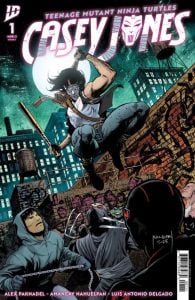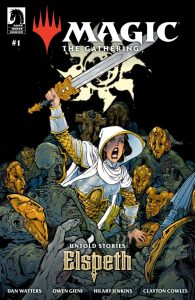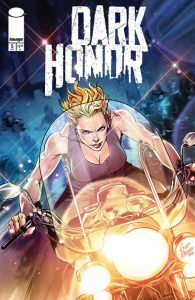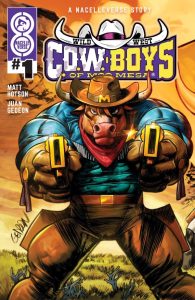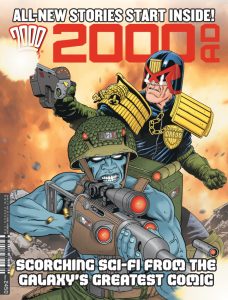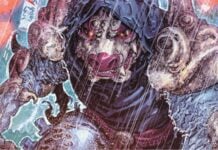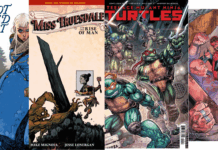In this week’s Wednesday Comics Reviews, the team reviews the new crime series Good As Dead #1, the spin-off series Teenage Mutant Ninja Turtles: Casey Jones #1, a spy thriller in No Man’s Land #1, and much more! Plus, FOC Watch and The Prog Report!
 Good As Dead #1
Good As Dead #1
Writer: David Lapham and Maria Lapham
Artist: David Lapham
Colorist: Dee Cunniffe
Publisher: Image Comics – Skybound
Review by Jared Bird
The town of Port Lindon has always been bound together by the Emissary Bridge, a symbol that connects its citizens to ideas of hope and opportunity. When one man, Joseph Yao, sets himself on fire on the bridge, it becomes the centrepoint of a vast conspiracy tying the whole town together. The newest comic from legendary creators David and Maria Lapham, Good as Dead weaves together classic noir fiction, small town horror, surreal sci-fi and vast conspiracy to tell a story about the average people who inhabit a place ready to explode.
Based on an initial concept and outline by Chris Black and David Alpert, Good as Dead follows Sheriff David Calhoun, the town’s lead lawman, who is forced to investigate Yao’s death before mysterious forces tear the town apart from the inside out. As he attempts to outrun his imminent demise, he will have to unpack generations of secrets around the Valades family, who effectively own the town, and have a personal connection to Calhoun and his past. Also involved is his revolutionary sibling Bobby, his police partner Lenore, a grieving teenage girl, and a reckless young man with deep connections to the town’s past. You can absolutely see why the Laphams were drawn to this concept, as it feels very thematically relevant to their work in Stray Bullets, but it also feels like a different narrative to that entirely. Each issue is double-sized, allowing the story time to breathe and really lean into its expansive scope. There’s already over half a dozen characters, and whilst the book has a lot going on, it never feels overwhelming or intimidating. Instead, the Laphams gradually unfurl more and more going on, and it still feels like it’s just the beginning. They give you just enough of each character that you become interested and engaged, but never too much where it feels like the book showing its hand too quickly. It’s a narratively rich first issue that invites you to read it more than once, in order to fully absorb the details of the story and narrative.
The Laphams are legendary in the comics business and for good reason. David Lapham’s artwork is wonderful, with a propulsive energy that brilliantly controls the flow of any given scene. He’s fantastic at drawing action sequences to this day, and the moments of explosive violence and tension are utterly brilliant. His work is colored here by Dee Cunniffe, and while it feels surreal to see Lapham working outside of his usual black and white, it looks fantastic. Cunniffe uses colors to brilliantly emphasize the atmosphere and aesthetics of any given sequence, enhancing Lapham’s artwork at every turn. His characters are aged, rugged and human, with a wide range of appearances and body types that is wonderful to see.
The Laphams do a wonderful job at scripting the book as well, with sharp and clever dialogue that fleshes out every character and gradually reveals information at an engaging, absorbing pace. They have a great knack at making characters feel deeply human and incredibly real in their work, and this series is no different. I eagerly look forward to seeing how the characters grow, change and evolve from here. The plotting is tight and efficient, with clever twists and turns that keep the suspense at a high level throughout the book, and there are several brilliant and explosive moments of release that really pack a punch here. It’s a great showing from the Laphams, who yet again prove why they work so well together.
Overall, Good As Dead #1 is one of the best first issues of the year. With wonderful artwork from David Lapham that makes the book feel hauntingly real and wonderfully atmospheric, and fantastic writing from David and Maria Lapham that leave the reader engaged in the stories of interesting, multifaceted characters, this vast conspiratorial narrative never feels too expansive or obtuse. Instead, it is a focused and effective crime story that gradually unfurls layer upon layer and leaves the reader desperate for more at every turn. Whilst some of the more extreme genre-bending twists have only been hinted at and are yet to be truly seen, the series already has a wonderful identity of its own, blending styles and expectations to create something striking and explosive. A brilliant and exciting start to what is already shaping up to be a fantastic series.
 Teenage Mutant Ninja Turtles: Casey Jones #1
Teenage Mutant Ninja Turtles: Casey Jones #1
Writer: Alex Paknadel
Artist: Amancay Nahuelpan
Colorist: Luis Antonio Delgado
Letterer and Designer: Darran Robinson
Publisher: IDW Publishing
Review by Zack Quaintance
I’ve really been enjoying the reinvigorated Teenage Mutant Ninja Turtles main book, driven by the powerhouse creative team of Jason Aaron and Juan Ferreyra, and I expect to continue enjoying it once they cede the reigns to Gene Luen Yang and Freddie E. Williams II. But I only really bring that up to point out that this first year of the new run has focused in depth on the four Turtles themselves, at times to the detriment of catching up with TMNT’s underrated supporting cast.
But the line is starting to change that, bringing in great creators to tell stories with the peripheral characters that flesh out the Turtles’ well-known world. Later this month, we’re getting a new Shredder book with Teenage Mutant Ninja Turtles: Shredder #1 from Dan Watters, Michele Bandini, and team. And then in September, we’re getting a Casey Jones centered series from Alex Paknadel, Amancay Nahuelpan, Luis Antonio Delgago, and Darran Robinson. This is, quite simply, great news.
See, Casey Jones had sort of been shunted away from the Turtles to make way for the current storyline, shot and left to recuperate largely off panel — until now. This book finds Jones still nursing his injuries, battling both the physical and emotional fallout. As the story in this new #1 progresses, Jones starts to get back to his old ways, wielding his sports gear and taking the fight to the streets of New York City.
In this way, I think it’s basically everything you could want from a Casey Jones comic. It feels easy enough to get into even if you’re not entirely up on the character’s recent history (there’s an inobtrusive and effective recap of his status quo), and it also reels you in with his fight to first recover and next to save a small mutant who’s about to be harmed by Jones’ former gang. There’s great character-centric work, classic Turtles ninja action, and a nice setup for what’s to come in the rest of this series.
I’ve written this before, but it’s a great time to be a Turtles fan. And books like Teenage Mutant Ninja Turtles: Casey Jones are keeping those good times rolling, bashing them along with a bent-ass golf club, as it were.
 Magic: The Gathering – Untold Stories–Elspeth #1
Magic: The Gathering – Untold Stories–Elspeth #1
Writer: Dan Watters
Artist: Owen Gieni
Color Artist: Hilary Jenkins
Letterer: Clayton Cowles
Publisher: Dark Horse Comics
Review by Jordan Jennings
Magic: The Gathering is a card game with a deep focus on storytelling. This is done somewhat through the cards, though it doesn’t always come across that clearly. To supplement and enrich the storytelling, Magic has done a whole host of tie-ins. There have been full print novels, serialized prose stories posted online, and, of course, comics. Magic: The Gathering: Untold Stories–Elspeth #1 is the latest in a long tradition of Magic: The Gathering comics and like most of the MTG comics, Untold Stories looks to fill the void in the lore of the characters. In this case, one of Magic’s most popular Planeswalkers, Elspeth.
Writer Dan Watters does a stellar job in filling new readers and fans of Magic with some of the important beats of Elspeth’s history from the 2014’s Theros Block to 2020’s Theros: Beyond Death. The issue serves as set up for Elspeth’s return from the dead and sets the stage for the events in Theros: Beyond Death. As a tie-in to the card game, this is wonderful world building and helps fill in some gaps that were left behind by the cards and the lack of any other story telling. The set came out during a time when Magic was trying to go back to doing print stories but quickly realized that it wasn’t as successful as they hoped. The comic tie-ins of the time also opted to tell stories not dealing with the sets directly. That means this is definitively an Untold Tale.
Watters does his best to make the comic approachable for new readers but there is going to be a learning curve here. There are a lot of assumptions going into this story that the reader will be familiar with these characters. That said, the story being told is ultimately an archetypal “Man vs Death” and “Man vs Gods” tale. It feels very Greek mythology and I loved it.
Owen Gieni does a STELLAR job in this issue. First, he can illustrate some absolutely monstrous beings with the antagonist Ashiok and the Phyrexians. Second, the way he illustrated the gods of Theros in the Nyx form is just stunning. They look like cosmic being befit of worship and help elevate the card imagery to the next level. Finally, Gieni and Watters play around with the panel layouts in an effective way. The pages are laid out in formalist 6 and 9 panel grids during the retelling of Elspeth’s history and nightmares.
These layouts are a great tool to give a lot of backstory in quick bite-sized chunks. They also create a great sense of pacing by giving this feeling of 1-5 second snips. Just a quick passage of time in each panel. Then they are useful to create a narrative call back as we see the story loop these moments over and over again in quicker succession as the page goes from 6 to the 9 panel grid. Generating a greater sense of moment until it finally breaks open. It’s positively exquisite and to see it in a licensed-comic is a delight.
I really enjoyed Magic: The Gathering: Untold Stories–Elspeth #1. The Greek Epic is captured quite well and it does a great job at making the story approachable. That said, I don’t know this is for everyone if only because of the steep learning curve. It is obvious this is a comic for the entrenched fan, and that is okay. I do think casual readers will find something to love here, though. For Magic: The Gathering fans, I highly recommend checking this one out.
 No Man’s Land #1
No Man’s Land #1
Writer and Artist: Szymon Kudrański
Letters: DC Hopkins
Publisher: Image Comics – One Man Art
Review by Clyde Hall
War. What’s it good for? Unlike Edwin Starr, writer Szymon Kudrański submits a few inconvenient truths about conflict in human evolution and even the willingness of going to war as a safeguard for peace. It’s timely for a murder mystery set in 1963, the conflicted era of Vietnam and Camelot.
In the first issue of his new miniseries No Man’s Land, Kudrański also cites “The President and the Press” speech by President John F. Kennedy to the American Newspaper Publishers Association in 1961. Delivered on the heels of the failed Bay of Pigs invasion of Cuba, Kennedy’s speech presented the need for secrecy in matters of national security as a reason for the free press to censor itself. He also spoke of spy-craft, espionage, and covert operations as ways to effectively wage a Cold War without relying on military operations or invasion.
Such noble notions abruptly collide with reality in the career of veteran FBI agent Kevin Collins. Collins has his 20 years in, and the world’s changed since his rookie days during World War II. Going above and beyond in his duties, Collins has sacrificed much of the family life he’s trying to protect. He has his early retirement paperwork ready to hand in when his supervisor calls him into a meeting with White House liaison General Fincher.
A body has been found in the Ice Curtain, a veritable No Man’s Land of frozen ocean connecting two islands in the Bering Strait. One belongs to the Soviet Union, the other to the United States. Jurisdiction there is extremely tricky, and while there are military bases in the region, Washington officials, still reeling from the Cuban Missile Crisis months earlier, prefer a more delicate investigation. Agent Collins’ retirement request is shelved in the interests of national security, and he’s assigned the case on behalf of the United States. He’s cautioned that the incident, if poorly managed, could be weaponized for the Soviet Union’s propaganda machine. Also, should he stray into their official territory, he’ll be arrested as a spy.
A new top secret assignment in lieu of a retirement package and gold watch goes over poorly at home. We see the quality of married life Collins’ career has inflicted on wife Lisa, and the price which comes due. The hazards of his assignment quickly come into focus as the veteran agent arrives in the inhospitable, frozen frontier.
The initial entry of No Man’s Land is cerebral. We don’t get shoot-em ups yet, nor even military troop posturing. What we do get, though, is a very insightful capture of the hottest season of the Cold War. The corner Kudrański writes Collins into is all too realistic and perilous given the saber rattling serenade between superpowers then…and their recent thermonuclear one-upmanship over Cuba.
The portrait of Collins, whether he turns out to be the solid, capable veteran the situation demands or the expendable, worn-down asset the Bureau can disavow, is masterful. In Kudrański’s narrative, the agent could easily become both. The writer invests us in Collins as an individual who put aside personal life and comforts for work he believed served his country and its citizens.
On both sides of the Iron Curtain, men and women worked dangerous espionage fields as a matter of necessity. They sacrificed much, at times all, in defense of their nation. And while dedicated men and women still perform such duties and with similar diligence today, Kudrański drafts his protagonist specifically in tones of that bygone era well. An era with a cultural revolution fast approaching which will call into question nearly every principle Collins stands for.
Kudrański’s artwork and color are fittingly monochromatic with exceptions reserved for pivotal moments of impact. Even before Agent Collins reaches the bleached snowcaps and bare rocky outcroppings of Alaska, the reader feels the frigidity of his work environment, the glacial coldness of his home life. He’s not just fighting a small, lonely corner of the Cold War. He’s been living it.
The lettering of DC Hopkins matches these aesthetics with officious sparseness. Which makes his contributions on sound effects, maps, and newspaper copy all the more impressive.
The opener of No Man’s Land left me hoping. Hoping for a second issue introduction to Collins’ KGB opposite number. Hoping for insights to Inuit residents and their lifestyle. Hoping for dished details on this international boundaries murder case. Hoping for more of what the first issue delivered, a thoughtful exploration of nuclear age intrigue set against a vast and icy wasteland.
For fans of Cold War storytelling, material like Bridge of Spies and most things John le Carré, this new offering from Image/One Man Art will be welcome as a warming shot of vodka on a subzero Siberian night.
 Dark Honor #5
Dark Honor #5
Created and Written by: K.S. Bruce and Brian Decubellis
Adapted By: Ethan Sacks
Artist: Jamal Igle
Colorist: Raciel Avila
Letterer: Jame
Publisher: Image Comics – Syzygy Publishing
Review by Khalid Johnson
By the conclusion of Dark Honor #5, I was left conflicted but also appreciative of seeing the hard work of all the creators involved. A reflection on the pandemic (which isn’t over, might I add) and specifically the height of quarantine in 2020, I think Dark Honor has a lot of heart thanks to writers K.S. Bruce, Brian Decubellis and Ethan Sacks. This is an action packed finale that has the charm of a big 80s action flick and ties things up with a bow. I really appreciated getting insight into the writers’ heads and what inspired them in their work, seeing the visual process of the artists they worked with and comparing that to our final result.
There is admittedly a thing that stuck out to me; though I know it wasn’t the focus. The framing of the protest, a vignette, doesn’t do justice to what was happening at the time and moves us through it quickly to the conclusion where the big set piece can take place. There’s a loaded conflict in the background on Rain’s return to a city where the protests have been characterized as violent clashes with police and speeds past a meaningful interrogation of why that would happen, when it’s more often than not the police agitating and escalating demonstrations. I feel the things that would have helped the world breathe are the details that are approached with a birds eye view.
In the art of Jamal Igle with colors by Raciel Avila and letters by Jame, I feel the love for the influences, from Japanese Ukiyo-e woodblock prints to mob films and old action films in the grittiness of the city and the big moments like the over the top villain who decides he wants to escalate. That is all endearing though sometimes that bird’s eye view can fly toward orientalism while centering a predominantly white cast and a blonde white lead. Rain is queer and I did enjoy that from page to page. I appreciate the foreboding quiet at the beginning of this issue, I enjoy how it dials up from the onset and how Rain is committed to the action. My conflict is largely that I wanted to connect more to the characters that Rain cared so deeply about.
 Wild West C.O.W. Boys of Moo Mesa
Wild West C.O.W. Boys of Moo Mesa
Writer: Matt Hotson
Artist: Juan Gedeon
Colorist: Carlos Cabrera
Letterer: Jeff Powell
Publisher: Oni Press
Review by Tim Rooney
FOC Watch
This comic is currently available for pre-order.
 The City Beneath Her Feet #2
The City Beneath Her Feet #2
Writer: James Tynion IV
Artist: Elsa Charretier
Colorist: Jordie Bellaire
Letterer: Aditya Bidikar
Publisher: DSTLRY Media
We usually reserve this space for upcoming new #1 comics, but we made an exception here for two reasons: 1. it’s been a long break since issue #1 landed in December; and 2. like all DSTLRY comics, this book is extra-sized.
But if I’m being honest, I jumped at the chance to let folks know this series is coming back because of the absolutely stunning artwork by Elsa Charretier, with colors by Jordie Bellaire (easily one of the best working colorists today).
Simply put, this is one of the best-looking comics in shops, and you should absolutely consider pre-ordering it and checking this issue out.
The Prog Report
2000AD 2450 (Rebellion Publishing): This week’s issue is made-up of all accessible, new beginnings, and for me, the two most notable are the lead story, Judge Dredd: And to the Sea Return, and Rogue Trooper: Ghost Patrol. I’m not going to write much about the Dredd story here, because I’m sure I’ll cover it as it progresses in the weeks to come (and also because last week I ran this piece about it). I’d rather talk about the other story. I’ve had trouble accessing Rogue Trooper as a character since I’ve started doing these weekly micro-reviews, aside from the excellent Blighty Valley story. But I was really excited for this new story, with its great creative team of writer Alex De Campi, artist Neal Edwards, colorist Matt Soffe, and letterer Jim Campbell. And this first chapter is really intriguing, setting up what a mystery and a trip through Rogue Trooper mythos that I found surprising, in a good way. It is, simply put, a nice start, and I’m excited to see where it goes. This week’s cover (above) is by Mark Sexton. As always, you can pick up a digital copy of The Prog here. —Zack Quaintance
Column edited by The Beat’s reviews editor, Zack Quaintance.
Read past entries in the weekly Wednesday Comics reviews series or check-out our other reviews here!




